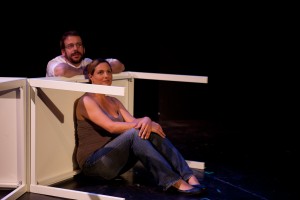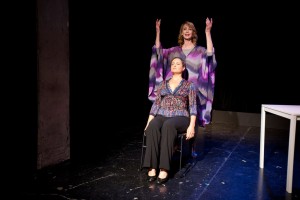“Do you feel like you’re in science class?” an audience member asked me as I stood in line for the restroom during the intermission of And It Spins Twice, playing as part of the New York International Fringe Festival. Shockingly, for a show set in parallel universes where three fourths of the characters are theoretical physicists discussing concepts like gravity, membranes and string theory, I did not feel like I was in science class.
It says a lot of playwright Alexis Roblan’s script, which uses clever metaphors like guitar strings and the Titanic to make these complex ideas a little easier to swallow. Instead of groaning at the mention of protons, neutrons and electrons, audience members will find themselves drawn into the two stories being told.
In one universe, Lucia Grillo plays Beth, a theoretical physicist and physics professor whose husband Ryan, played by Thom Christensen, has just left her. Grillo’s Beth is either angry or weepy throughout the show, which is understandable given her circumstances. But despite all her crying, it never really made me care.
In the other universe, a more compelling story unfolds, thanks in part to the wonderful chemistry between Marlena Kalm’s Liz (a theoretical physics graduate student) and Thom Christensen’s parallel universe version of Ryan (a singer/songwriter obsessed with the idea that somewhere out there in the vast expanse of space, another version of himself could be Bono.) The two are just starting out their relationship, which is dotted with humor. When Liz tells Ryan she’s addicted to his eyes, he retorts, “Not my hot 40-year-old-man body?” But their relationship gains a depth to it as the piece progresses and the two take on much more meaningful conversations.
In both universes, Liz and Beth are approached by June (Julia Campanelli), a “cosmologist, astrologer, author, healer and inspiration” to Beth and a world-renowned physicist to Liz. She’s convinced that Liz and Beth’s equation for predicting the collision of two universes’ membranes is correct, and that the time is now.
Director Michael Padden does a great job staging the show, seamlessly flowing between the two parallel universes with the help of lighting designer and stage manager Joe Cabrera. Though the set is not elaborate, consisting of only two tables and three chairs, it is more than adequate. The minimal set helps the audience to focus and contemplate on the questions being raised throughout the show.
And perhaps the most moving question is whether or not there is a rhyme or reason for anything. Both Liz and Beth at one point during the play wonder, “I never thought there was a plan, but there are supposed to be rules, aren’t there?”



